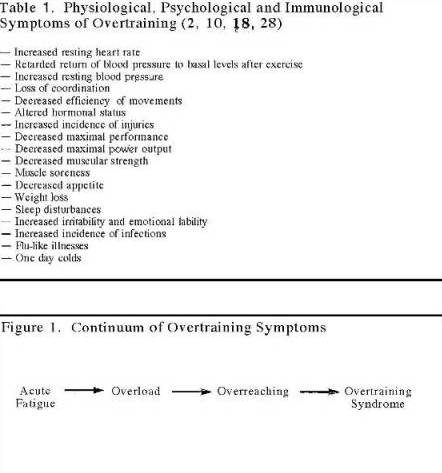Contributing Factors to Anaerobic Overtraining
While many physiological factors appear to contribute to over training, just as many variables contribute to enhanced physical performance, and many variables may potentially contribute to over training. In addition, different factors may contribute to overtraining in anaerobic and aerobic activities. Therefore, much of the overtraining research using aerobic activities may not apply to anaerobic training (e.g., sprinting, field events, resistance training, etc.). Based on available information anaerobic overtraining, and on related physiological data, a theoretical sequence of anaerobic over training maladaptations is illustrated in Figure 2.

As can be seen, many physiological systems are dependent on each other for optimal function. Dysfunction of one system (e;g., altered neuron function) can lead to a considerable cascade of physiological events. For example, some aspects of performance, such as strength, may be more sensitive to the acute effects of overtraining than others.
Previous research has attempted to identify physiological variables that can serve as markers for the onset of overtraining. This seemingly simple task, however, has many problems. As seen in Figure 2, numerous physiological properties may be affected without actually altering physical performance. Additionally, various individuals and activities may demonstrate differential sequences of adaptation. As a result, what appears to be a marker in one situation may not occur in another situation. Possible examples of this might be the shot putter who is particularly affected by. decreased motor coordination, and the 400-meter sprinter who may be most affected by decreased muscle glycogen levels. To compound matters further, some individuals may experience decreased performances at a later stage than others. Therefore, attempting to identify contributing factors to overtraining is a difficult task, and it is difficult to determine which of the measurable contributing factors actually precedes overtraining.
Research devoted to anaerobic overtraining has primarily investigated increased training volumes. The role of increased training intensity on the development of anaerobic over training has received little attention (9). The common factor for each of these studies has been the difficulty of inducing performance decrements on a variety of easily administered field tests and laboratory evaluations. Recent work has focused on the role of hormonal function and status with overtraining. It appears that the endocrine system is altered by anaerobic overtraining (7, 8), and may provide one mechanism of long-term adaptation. It appears, however, that there is no simple explanation for the cause of anaerobic over training.
